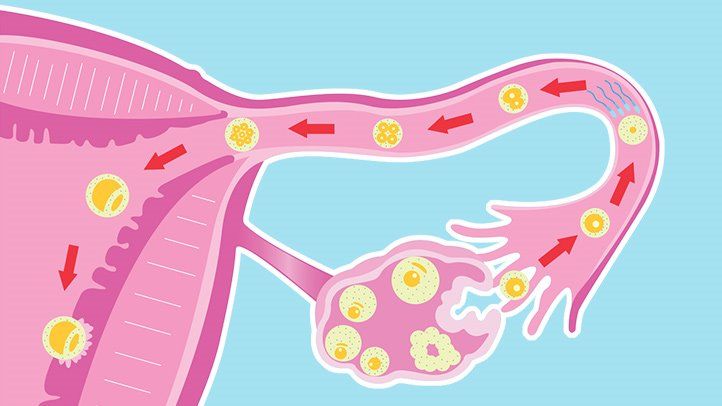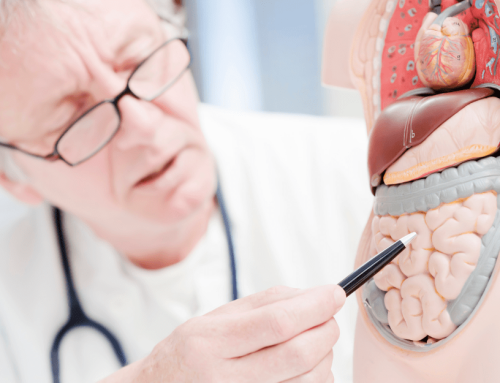By Ward Dean, M.D.
Some of the most common symptoms physicians hear from their female patients are problems with weight gain, fatigue, loss of libido, depression, headaches, joint pain and mood swings. Other frequently discovered problems include uterine fibroids, cancer, fibrocystic breast disease, menstrual problems, autoimmune disorders, pre-menopausal bone loss and a high incidence of osteoporosis after menopause. Many physicians and scientists are becoming increasingly aware of a common link between these symptoms and diseases and that common link is often an imbalance between the primary female sex hormones, progesterone and estrogen.(1)
Studies show that by restoring the estrogen: progesterone hormonal balance to normal levels, many women report dramatic improvement. Researchers in one study were so impressed with the effectiveness of topically-applied natural progesterone, they reported that [Our] results suggest that osteoporosis is not an irreversible condition. But first its important to understand what makes these complex chemical messengers tick.
The word hormone comes from a Greek word meaning arouse to activity. Progesterone and estrogen along with DHEA, pregnenolone, and cortisol are classified as steroid hormones.
Progesterone is made in the ovaries of menstruating women. It is produced by the corpus luteum at the time of ovulation (20-25 mg./day), and by the placenta during pregnancy (up to 300-400 mg./day). Progesterone is a precursor to most steroid hormones and performs a myriad of different functions. (Table I) (2,3,4,5,6)
|
TABLE I : |
|
FUNCTIONS OF PROGESTERONE |
|
The Estrogen Dominance Syndrome
According to research pioneer Dr. John Lee, many women suffer from a syndrome known as Estrogen Dominance. Estrogen, unopposed by progesterone, results in a number of adverse effects. These include hypertension, salt and water retention, abnormal blood clotting, excessive body fat, hypothyroidism, painful breasts, fibrocystic breast disease, increased risk of gallbladder disease and gallstones, liver dysfunction, increased risk of endometrial cancer of the uterus and breast cancer.
Estrogen dominance occurs at the age of menopause when progesterone production virtually ceases, plummeting to approximately 1% of its premenopausal level. At the same time the production of estrogen only falls to about 50% of its premenopausal level. This dramatically alters the estrogen: progesterone ratio, and the estrogen becomes toxic to the body without progesterone to stop it. As a result, the risks for breast and uterine cancer, fibrocystic breasts, ovarian cysts, uterine fibroids, cervical erosions and/or dysplasia, and osteoporosis rise.
The problems of estrogen dominance are not confined to menopausal woman only. Today, it is extremely common for women to experience recurring menopause-type complaints that begin 10 to 15 years before the time of their menopause when menstruation ceases. Woman as young as thirty years of age are complaining of menopause-type problems. This is known as pre-menopause syndrome. The typical complaints are: fatigue, depression, water retention, weight gain, mood swings, loss of sex drive, irritability, headaches, slow metabolism and cravings for sweets.(7)
Progesterone and Osteoporosis
One common and almost universal change with age is loss of bone density. When this loss becomes severe enough, it is diagnosed as osteoporosis, the disfiguring and potentially fatal brittle-bone disease. In many western countries, patients with hip fractures occupy more hospital beds than patients with any other disease. For more than fifty years physicians have believed that lack of estrogen was the primary cause of osteoporosis. Quite simply, a lack of estrogen does not cause osteoporosis.(8) For example, tamoxifen citrate, an anti-estrogen drug that is prescribed for breast cancer-prone women, blocks the uptake of estrogen hormones. If lack of estrogen were the cause of osteoporosis, then tamoxifen would increase bone resorption and cause loss of bone density. Tamoxifen does not cause that to occur. (9) In addition, there is significant bone loss during the 10 to 15 years before menopause, despite an ample supply of estrogen. But during that time, there is often a shortage of progesterone. Although estrogen inhibits the bone-destroying osteoclast cells, it cannot rebuild bone.(10,11)
On the other hand, progesterone rebuilds bone by stimulating the osteoblast cells that remineralize and restore bone mass. Supplementing with natural progesterone has proved useful to prevent and heal osteoporosis.(11) Osteoporosis becomes most severe following menopause when womens bodies stop producing progesterone. Dr. John Lee and many other physicians say progesterone is a key to maintaining healthy bones.(12,13)
Dr. Lee reported in the July, 1990 issue of International Clinical Nutrition Review on the effectiveness of natural progesterone. It was common to see a 10 percent increase (in bone density) in the first six to 12 months, and an annual increase of three to five percent until stabilizing at the levels of healthy 35-year-olds. Lee adds, The occurrences of osteoporotic fractures dropped to zero. Dr. Lees results run counter to current medical thinking about osteoporosis. The results of this study suggest that osteoporosis is not an irreversible condition, he says. Reversal has been demonstrated by the bone density tests and by the clinical results. This cannot be said of any other conventional therapy for osteoporosis. (14,15,16,17)
The Progesterone Solution
As mentioned previously, estrogen dominance causes many problems for women, including PMS, premenopausal syndrome, and osteoporosis. Since these conditions have the common cause of estrogen dominance and relative progesterone deficiency, they also have a remarkably simple common cure i.e., supplement the body with physiologic dosages of natural progesterone (approximately 20-30 mg./day) to overcome the estrogen dominance and reestablish hormonal balance. (7)
Natural vs. Synthetic Progesterone
Theres a world of difference between natural progesterone and synthetic progesterone, the type most frequently prescribed by orthodox physicians. Provera, the most frequently prescribed synthetic progesterone is not really progesterone at all it is a progestin. Progestins are synthetic progesterone-like compounds that are manufactured by pharmaceutical companies. These synthetic progesterones are far more powerful than the bodys own natural progesterone and are metabolized as foreign substances into toxic by-products. These synthetic progesterones can gravely interfere with the bodys own natural progesterone, thus creating other hormone-related health problems and further exacerbating estrogen dominance. (18) Side effects of synthetic progesterone include increased risk of cancer, abnormal menstrual flow, nausea, depression, masculinizing effects, and fluid retention.(19, 20)
Natural progesterone is nearly identical to what the body produces. It is manufactured in scientific laboratories from wild yams and soy beans. On the other hand, yam-derived natural progesterone should not be confused with yam extracts that are sold in health food stores. The body easily converts natural progesterone into the identical molecule made by the body. The body cannot, however, convert the yam extracts into progesterone.21 Adverse side effects are very rare with natural progesterone.(22) The only side effect of concern is that it might slightly alter the timing of the menstrual cycle, when taken inappropriately.
Routes of Progesterone Delivery
Natural progesterone can be administered orally, topically, or by injection. However, I believe that the best way is topically (transdermally). Transdermal delivery is gaining in popularity as evidenced by the growing use of estrogen, testosterone, nitroglycerine (for angina) and even nicotine patches.(23,24)
Equivalent dosages of transdermal natural progesterone are 5 to 7 times more effective than orally ingested natural progesterone. Only 10-15% of the orally ingested progesterone reaches the bloodstream. (25,23) Therefore, it is necessary to take much higher doses, 100-200 mg./day, of oral progesterone to obtain the equivalent benefit of 20-30 mg./day of transdermal progesterone.
Once progesterone reaches a saturation level in the underlying skin tissue, it diffuses into the capillaries, then passes into the general blood circulation for use by the body. Some women feel effects in less than a week of usage. For those who are especially deficient in progesterone, it may take two to three months to restore optimum levels. (7,26)
Not All Topical Progesterones Are the Same
A word of warning: not all trans-dermal delivery preparations of progesterone are capable of carrying the hormone through the skin. Adding progesterone to a typical cosmetic moisturizer (which is what many companies do) often results in a product that does not effectively penetrate the skin.
An ideal delivery vehicle is an oil-water emulsion that contains components of the fatty tissue of the skin, as well as permeation enhancers and stabilizers in a synergistic balance. The permeation enhancers enable the progesterone to pass the skin barrier. (27) A transdermal progesterone cream should contain at least 400 mg. of natural progesterone per ounce. Each one-half teaspoon application would thereby supply a minimum of 26 mg. of progesterone. Independent studies reveal that many commercial progesterone cream products contain less than 15 mg. of progesterone per ounce. In fact, some of these creams containing as little as 2 mg. of progesterone per ounce! (28) It should be emphasized that creams containing only wild yam extract (diosgenin) but no U.S.P. progesterone have absolutely no effect on the level of progesterone in the body.
References:
1. Lipsett, M.P. Steroid hormones, in Reproductive Endocrinology, Physiology, and Clinical Management. Yen, S.S.C., and R.B. Jaffe, eds. Philadelphia: W.B. Saunders Co., 1978.
2. Goodman, L. & Gilman, A. The Pharmacological Basis of Therapeutics. Toronto, McMillan, 8th edition, chapter 58, 1990.
3. Thomas, J. & Gillham, B. Wills Biochemistry Basis of Medicine. Oxoford, Butterworth-Heinenman Ltd. 1989.
4. Ellison, P,T., et al, The ecological context of human ovarian function. Human Reproduction. 8:2248-58, 1993.
5. Elks, Peripheral effects of steroid hormones, implications for patient management, JAMWA. 48:41- 55, 1993.
6. Tietz, N., ed. Textbook of Clinical Chemistry, Philadelphia, W.B. Sanders Co., 1085-1171, 1986.
7. Lee, J.R. What Your Doctor May Not Tell You About Menopause. Warner Books, May, 1996.
8. Barzel, U.S. Estrogens in the prevention and treatment of postmenopausal osteoporosis. Am J of Med. 85:847-50, 1988.
9. Love, R., et al. Effects of tamoxifen on women with breast cancer, New England Journal of Medicine, 326: 852-6, 1992.
10. Harrisons Principles of Internal Medicine. 12th edition , 1991.
11. Prior, J.C. Progesterone as a bone-trophic hormone. Endocr Rev,11:386-98, 1990.
12. Prior, J.C. et al, Progesterone and the prevention of osteoporosis, Canadian Journal of Obstetrics/Gynecology & Womens Health Care, 3:178-84, 1991.
13. Lee, J.R. Is natural progesterone the missing link in osteoporosis prevention and treatment? Medical Hypotheses, 35:316-18, 1991.
14. Lee, J.R. Osteoporosis reversal: the role of progesterone Intern Clin Nutr Rev, 10:384-91, 1990.
15. Lee, J.R. Osteoporosis reversal with transdermal progesterone (letter). Lancet, 336:1327, 1990.
16. Lee, J.R. Slowing the Aging Process with Natural Progesterone, BLL Publ. California, USA, 1994.
17. Lees, B., et al. Differences in proximal femur density over two centuries. Lancet, 341:673-75, 1993.
18. Edgren, R.A. Clinical Use of sex hormones, Year Book Medical Publications, 1980.
19. Physicians Desk Reference (PDR). 46th Edition, Montvale, N.J. Medical Economics Data, 2356, 1992.
20. Bergkvist, L., et al . The risk of breast cancer after estrogen and estrogen-progestin replacement. New England Journal of Medicine, 321:293-97, 1989.
21. Hargrove, et al. Menopausal hormone replacement therapy with continuous daily oral micronized estradiol and progesterone. Sciences, Vol. 84, No. 9, Sept. 1995. Pages 1144-1146, 1995.
22. Ottoson, U.B., et al. Subtractions of high-density lipoprotein cholesterol during estrogen replacement therapy: a comparison between progestins and natural progesterone. American Journal of Obstetrics and Gynecology, 151:746-50,1985.
23. Johnson, et al. Permeation of steroids through human skin. Journal of Pharmaceutical Sciences, Vol. 84, No. 9, Sept. 1995. Pages 1144-1146, 1995.
24. Hadgraft, J. & Guy, R.H. Transdermal Drug Delivery, Volume 35, Drugs and the Pharmaceutical Sciences, Marcel Dekker, 1989.
25. Chien, Y.W. Novel Drug Delivery Systems. 2nd Ed., Drugs and the Pharmaceutical Sciences, Volume 50, Marcel Dekker, 1992.
26. Barry, B.W. Dermatological Formulations. Percutaneous Absorption. Drugs and the Pharmaceutical Sciences, Volume 18, Marcel Dekker, 1983.
27. Waiters, K.A. Penetration enhancers and their use in Transdermal Therapeutic Systems, in Transdermal Drug Delivery, Volume 35, Drugs and the Pharmaceutical Sciences Marcel Dekker, 1989.
28. Lee, John R. What Your Doctor May Not Tell You About Menopause Range of Progesterone Content of Body Creams & Oils prepared by Aeron Lifecyles. Warner Books, May, 1996






